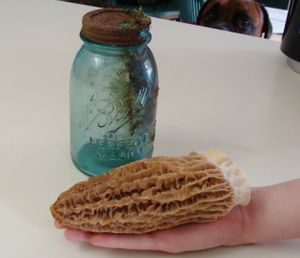At least a few morel gathering secrets can be shared
WILD EDIBLES -- Last year was a lousy season for picking morel mushrooms in much of the Inland Northwest. This season has been stellar by all reports.
So here's a collection of universal mushrooming tips and wisdom from Kenny Morris, Yakima-area mushroom enthusiast, as told to Scott Sandsberry of the Yakima Herald-Republic and summarized by me:
- Hit the areas that have produced mushrooms in the past. If they’re not there, try another area.
- Drive forest roads to look for "roadies" along the road to help peg the elevation where mushrooms are emerging.
- Stop and search spots for 5-10 minutes. If you find none, try another spot, working uphill.
- at one high-country pullout, and if he finds no morels — or, at some spots, if he finds only a few — he’ll be back in his rig to drive to the next likely spot.
- Mother’s Day is an unofficial Opening Day for morel gathering.
- Lupine is an indicator. If the green lupine base (not the colorful flowering top) is roughly six inches high, it’s morel time.
- In early season, look around rocks and trees that will have been heated by the sun where morels often sprout in the warmer ground.
- Follow the snowline. Wherever melting snow has been replaced by warming sunlight, the morels are apt to follow. In a spring like this one, with so little snow in the high country, it can be a case of following the rain or checking darker, cooler canyons and slopes.
- Check both sides of the ridge. If the sunny side isn’t getting morels, cross over to the shady side.
- Wildflowers such as trillium or wild strawberries and certain types of trees, notably larch or white fir often are associated with morels.
- Don’t get discouraged. Even the experts sometimes have to try numerous spots to find a payload.
- Get tips from the Forest Service of areas burned by forest fires or controlled burns. Morels are known to emerge in high number in areas that burned the previous year.
Two other tips from expert mushroomers in the Spokane area:
-
Cut or pinch the stem off at the base, leaving part of the mushroom there. Some experts say they are more likely to grow back if you leave part of the "roots" in the ground.
-
Carry harvested mushrooms in a basket or mesh bag. This helps them from getting too moist, and it some experts believe it lets their spores fall through and spread around the area- causing more to grow in coming years.

